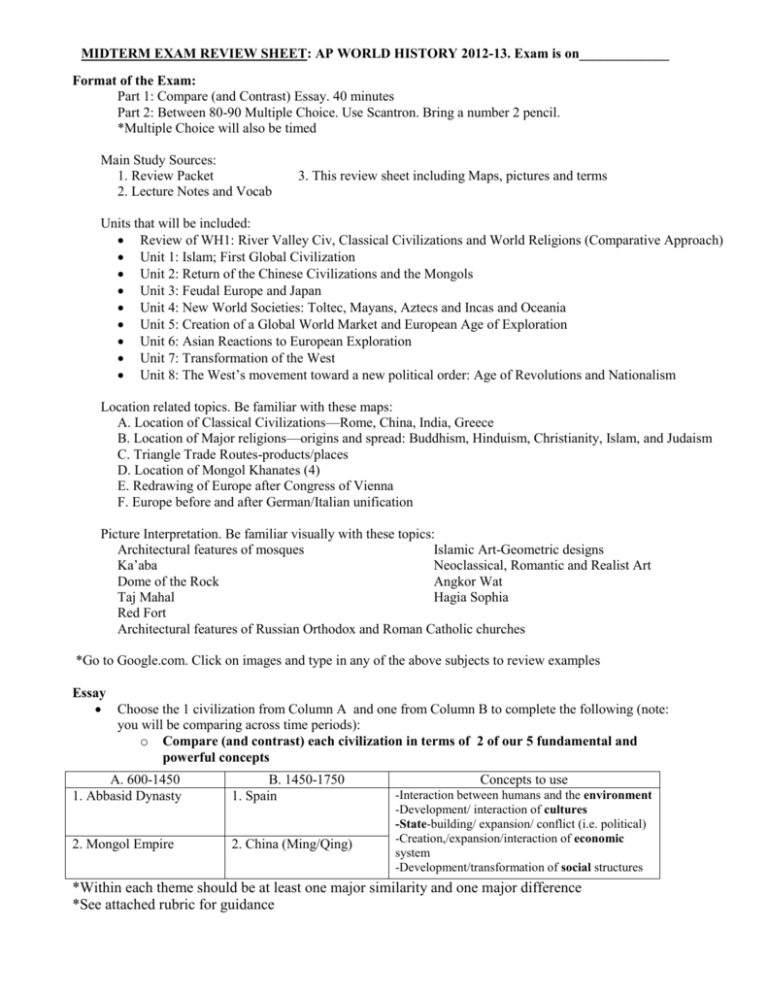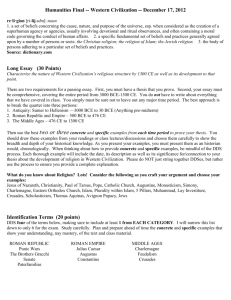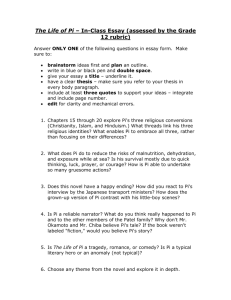MIDTERM EXAM REVIEW SHEET: AP WORLD HISTORY
advertisement

MIDTERM EXAM REVIEW SHEET: AP WORLD HISTORY 2012-13. Exam is on_____________ Format of the Exam: Part 1: Compare (and Contrast) Essay. 40 minutes Part 2: Between 80-90 Multiple Choice. Use Scantron. Bring a number 2 pencil. *Multiple Choice will also be timed Main Study Sources: 1. Review Packet 2. Lecture Notes and Vocab 3. This review sheet including Maps, pictures and terms Units that will be included: Review of WH1: River Valley Civ, Classical Civilizations and World Religions (Comparative Approach) Unit 1: Islam; First Global Civilization Unit 2: Return of the Chinese Civilizations and the Mongols Unit 3: Feudal Europe and Japan Unit 4: New World Societies: Toltec, Mayans, Aztecs and Incas and Oceania Unit 5: Creation of a Global World Market and European Age of Exploration Unit 6: Asian Reactions to European Exploration Unit 7: Transformation of the West Unit 8: The West’s movement toward a new political order: Age of Revolutions and Nationalism Location related topics. Be familiar with these maps: A. Location of Classical Civilizations—Rome, China, India, Greece B. Location of Major religions—origins and spread: Buddhism, Hinduism, Christianity, Islam, and Judaism C. Triangle Trade Routes-products/places D. Location of Mongol Khanates (4) E. Redrawing of Europe after Congress of Vienna F. Europe before and after German/Italian unification Picture Interpretation. Be familiar visually with these topics: Architectural features of mosques Islamic Art-Geometric designs Ka’aba Neoclassical, Romantic and Realist Art Dome of the Rock Angkor Wat Taj Mahal Hagia Sophia Red Fort Architectural features of Russian Orthodox and Roman Catholic churches *Go to Google.com. Click on images and type in any of the above subjects to review examples Essay Choose the 1 civilization from Column A and one from Column B to complete the following (note: you will be comparing across time periods): o Compare (and contrast) each civilization in terms of 2 of our 5 fundamental and powerful concepts A. 600-1450 1. Abbasid Dynasty B. 1450-1750 1. Spain 2. Mongol Empire 2. China (Ming/Qing) Concepts to use -Interaction between humans and the environment -Development/ interaction of cultures -State-building/ expansion/ conflict (i.e. political) -Creation,/expansion/interaction of economic system -Development/transformation of social structures *Within each theme should be at least one major similarity and one major difference *See attached rubric for guidance Key Terms and People to Know The underline words are the key terms/people to know. In cases when the word stands by itself make sure you are well acquainted with its definition 1. Impact of Aryans on India 30. Emergence, location and characteristics of Swahili 2. St. Benedict and the Benedictines culture 3. Paul’s contribution to spread of Christianity 31. Mansa 4. Characteristics of Hunter-Gatherers 32. Declaration of the Rights of Man 5. 2 Main contributions of Phoenicians 33. Janissaries 6. Social Structure of Feudalism 34. Treaty of Tordesillas and the Line of Demarcation 7. Monasticism- 35. Comparisons between a Viceroy and Vizier 8. 5 pillars of Islam 36. Lorenzo De Medici’s contribution to renaissance 9. Brahman 37. Bakufu 10. Johann Gutenberg’s invention 38. Daimyo 11. Characteristics of Great Zimbabwe 39. Copts-location and religion 12. Ashanti 39.Location of Savanna in Africa 13. Negatives of Aurangzeb rule of the Mughal 40. Quipu 14. Features/effects of Neolithic Revolution, including 41. Features, examples of goods and impact of Colombian gender relations Exchange 15. Civilizations and comparisons of Mandate of Heaven. 42. Middle Passage Ma’at Principle and Divine Right 43. Identify and characterize Gunpowder Empires (1450- 16. Differences between Cores and Peripheries 1750) 17. Differences between Fudai and Tozama 44. Committee of Public Safety 18. Achievements of Kepler Galileo 45. Edict of Nantes Newton Harvey Copernicus Vesalius 19. Beliefs of Confucianism 46. Absolutism and examples Daoism Legalism 47. Roots of Nationalism and its impact in Europe and 20. Contribution of Rene Descartes to Scientific Latin America Revolution 48. Four Noble Truths 21. Role in French Government: Estates General 49. Founders of the 5 World Religions 22. Manorialism/Fief 23. Shogunate 24. Beliefs/Solutions of John Locke, Jacques Rousseau, Montesquieu, Hobbes, Voltaire 50. Westernization by Russia under Peter the Great 51. Characteristics of Haitian Revolution 52. Congress of Vienna decisions, goals and outcomes 25. Guilds 26. Manchus 27. Dowry/Foot Binding 28. Golden Horde 29. Martin Luther 53. Location, culture, political structure/empire and trade products of the major cities between 600 and 1750: Venice, Mombasa, Mogadishu, Timbuktu, Cairo, Canton, Macao, Constantinople, St. Petersburg Thesis Construction Compare Essay Essay Prompt: Compare (and contrast) each civilization in terms of 2 of our 5 fundamental and powerful concepts Civilization A__________________________ Civilization B_____________________________ Abbasid or Mongol Empire Concepts used to Compare Similarity within theme Spain or China Difference within theme 1. 2. Thesis: Be sure to include civilizations, concepts and at least one similarity and one difference and one piece of analysis (why or how). _____________________________________________________________________________________ _____________________________________________________________________________________ _____________________________________________________________________________________ _____________________________________________________________________________________ _____________________________________________________________________________________ _____________________________________________________________________________________ _____________________________________________________________________________________ _____________________________________________________________________________________ _____________________________________________________________________________________ _____________________________________________________________________________________ _____________________________________________________________________________________ _____________________________________________________________________________________ _____________________________________________________________________________________ _____________________________________________________________________________________ _____________________________________________________________________________________ _____________________________________________________________________________________ Compare Essay Rubric Name___________________________ MIDTERM EXAM ESSAY Basic Core 1. Thesis Statement: 13 Points ____Addressed 2 concepts to compare (2) ____Identifies the two civilizations, one from column A and one from column B, to compare (2) ____At least one similarity and one difference per topic (4) ____At least one piece of analysis (2) ____Explicit and clear (3) 2. Topics of Comparison: 4 points ____At least one direct similarity per topic (2) ____At least one direct difference per topic (2) 3. Evidence: 4 points ____At least one piece of evidence per similarity (names, dates, events, developments) (2) ____At least one piece of evidence per difference (names, dates, events, developments) (2) 4. Analysis: 4 points ____Provides a reason or cause for each similarity (2) ____Provides a reason or cause for each difference (2) 5. Mechanics 8 points Proper Organization and flow ____Topic Sentences (2)- Identify concept and the fact that there are similarities and differences ____Paragraphs with complex sentences (3)- thesis paragraph and 2 body paragraphs ____Clear Conclusion paragraph (1) ____Free from spelling and grammar errors (2) Expanded Core: 2 checks equal 1 point added to score ____Has a clear, analytical, and comprehensive thesis ____Analyzes all parts of the question thoroughly (as relevant): comparisons, chronology, causation, connections, themes, interactions, content ____Provides ample historical evidence to substantiate thesis. ____Relates comparisons to larger global context. ____Makes several direct comparisons consistently between or among societies. ____Consistently analyzes the causes and effects of relevant similarities and differences. ____Arguments in body follow order of thesis ____Effective transitions throughout essay Total: __________ /37





